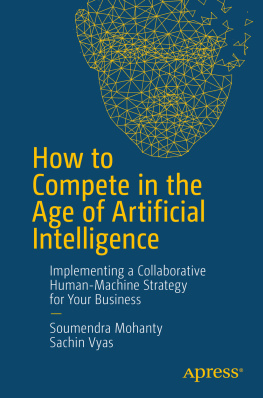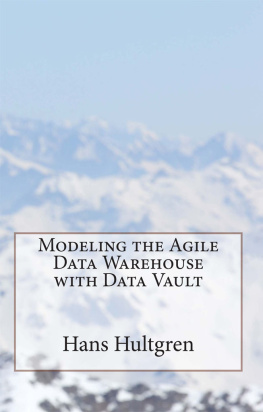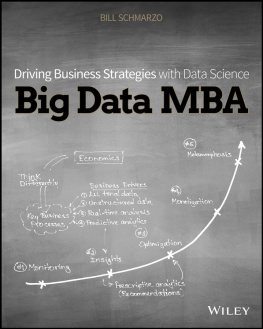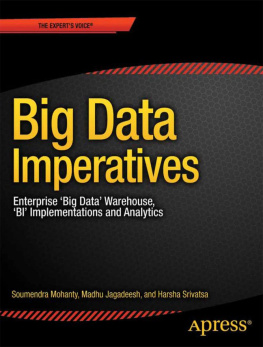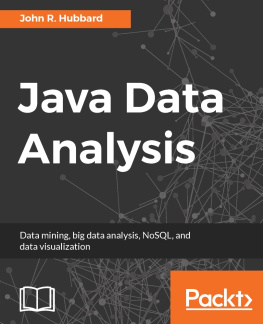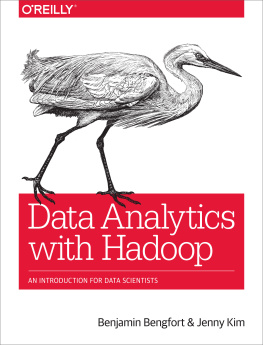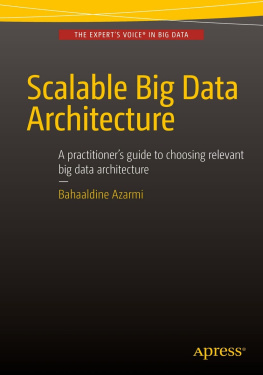Soumendra Mohanty - Big Data Imperatives: Enterprise ‘Big Data’ Warehouse, ‘BI’ Implementations and Analytics
Here you can read online Soumendra Mohanty - Big Data Imperatives: Enterprise ‘Big Data’ Warehouse, ‘BI’ Implementations and Analytics full text of the book (entire story) in english for free. Download pdf and epub, get meaning, cover and reviews about this ebook. year: 2013, publisher: Apress, genre: Business. Description of the work, (preface) as well as reviews are available. Best literature library LitArk.com created for fans of good reading and offers a wide selection of genres:
Romance novel
Science fiction
Adventure
Detective
Science
History
Home and family
Prose
Art
Politics
Computer
Non-fiction
Religion
Business
Children
Humor
Choose a favorite category and find really read worthwhile books. Enjoy immersion in the world of imagination, feel the emotions of the characters or learn something new for yourself, make an fascinating discovery.
- Book:Big Data Imperatives: Enterprise ‘Big Data’ Warehouse, ‘BI’ Implementations and Analytics
- Author:
- Publisher:Apress
- Genre:
- Year:2013
- Rating:5 / 5
- Favourites:Add to favourites
- Your mark:
Big Data Imperatives: Enterprise ‘Big Data’ Warehouse, ‘BI’ Implementations and Analytics: summary, description and annotation
We offer to read an annotation, description, summary or preface (depends on what the author of the book "Big Data Imperatives: Enterprise ‘Big Data’ Warehouse, ‘BI’ Implementations and Analytics" wrote himself). If you haven't found the necessary information about the book — write in the comments, we will try to find it.
Big Data Imperatives, focuses on resolving the key questions on everyones mind: Which data matters? Do you have enough data volume to justify the usage? How you want to process this amount of data? How long do you really need to keep it active for your analysis, marketing, and BI applications?
Big data is emerging from the realm of one-off projects to mainstream business adoption; however, the real value of big data is not in the overwhelming size of it, but more in its effective use.
This book addresses the following big data characteristics:
- Very large, distributed aggregations of loosely structured data often incomplete and inaccessible
- Petabytes/Exabytes of data
- Millions/billions of people providing/contributing to the context behind the data
- Flat schemas with few complex interrelationships
- Involves time-stamped events
- Made up of incomplete data
- Includes connections between data elements that must be probabilistically inferred
Big Data Imperatives describes the complementary nature of traditional data warehouses and big-data analytics platforms and how they feed each other. This book aims to bring the big data and analytics realms together with a greater focus on architectures that leverage the scale and power of big data and the ability to integrate and apply analytics principles to data which earlier was not accessible.
This book can also be used as a handbook for practitioners; helping them on methodology,technical architecture, analytics techniques and best practices. At the same time, this book intends to hold the interest of those new to big data and analytics by giving them a deep insight into the realm of big data.
What youll learn
- Understanding the technology, implementation of big data platforms and their usage for analytics
- Big data architectures
- Big data design patterns
- Implementation best practices
This book is designed for IT professionals, data warehousing, business intelligence professionals, data analysis professionals, architects, developers and business users.
Table of Contents- The New Information Management Paradigm
- Big Datas Implication for Businesses
- Big Data Implications for Information Management
- Defining Big Data Architecture Characteristics
- Co-Existent Architectures
- Data Quality for Big Data
- Data Security and Privacy Considerations for Big Data
- Big Data and Analytics
- Big Data Implications for Practitioners
Soumendra Mohanty: author's other books
Who wrote Big Data Imperatives: Enterprise ‘Big Data’ Warehouse, ‘BI’ Implementations and Analytics? Find out the surname, the name of the author of the book and a list of all author's works by series.


